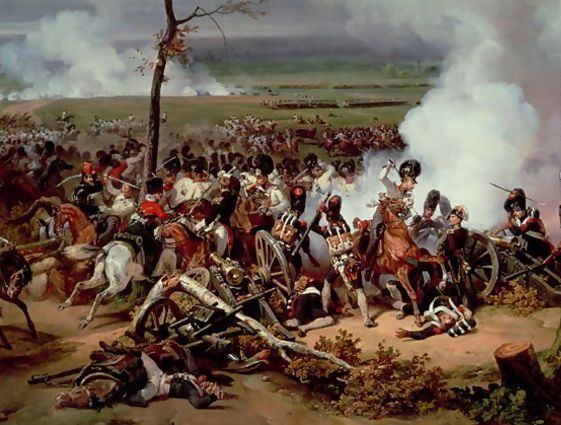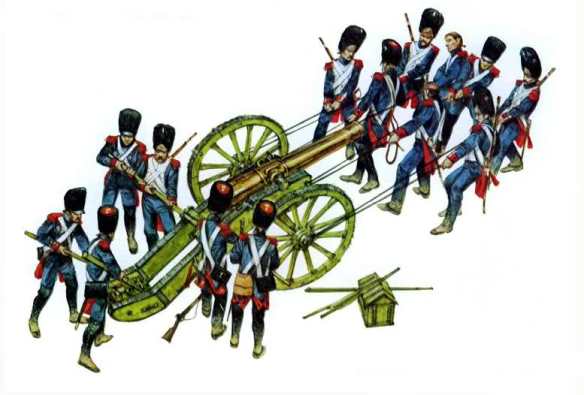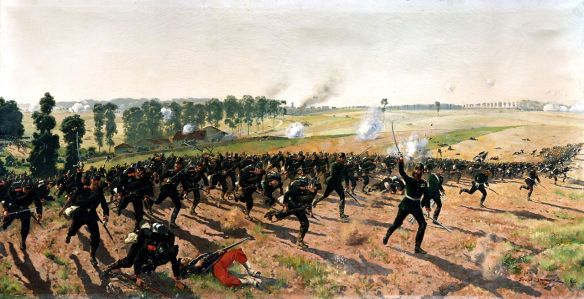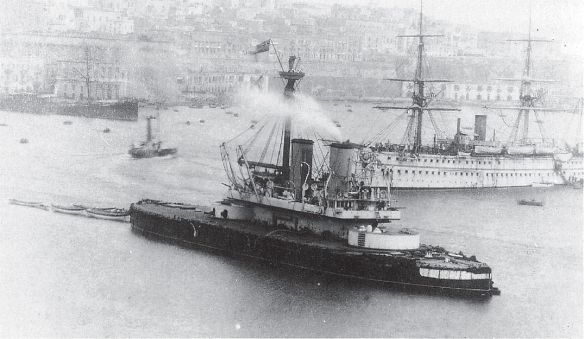Improvements in weapons technology, fueled by the Industrial Revolution, helped make warfare in the late 18th and 19th centuries more deadly and sophisticated. Civilians were drawn into wars more deeply than before, both as targets of enemy forces and as conscripts bound to military service. As traditional military powers, including the Ottoman Empire and China, lagged, Western nations expanded their global imperialistic aims. Although most of this period’s wars pitted nation against nation, warfare against internal foes, including America’s indigenous people and nomadic peoples and rebels in China, was also widespread.
Weaponry Trends. Although the ballistics revolution did not fundamentally change the tools of Western warfare, it significantly improved their effectiveness. Guns, artillery, and warships continued to be the basic components of combat, but all benefited from innovations linked to the developing sciences of engineering, physics, and chemistry. Smoothbore muskets began to give way to rifled guns that permitted much greater accuracy and impact. Cannons with rifled interiors and shapes that took account of air resistance could propel their payloads farther more precisely. As steam power replaced sails, and steel hulls replaced wooden ones, warships became stronger, faster, and more dependable. The development of interchangeable components by American Eli Whitney and others made it easier for even inexperienced soldiers to set up, load, fire, and repair both cannons and guns. Gunpowder, invented much earlier in China, was also reengineered for greater force and reliability.
Manpower Trends. Wars became bigger in the 18th and 19th centuries, partly because of new military and political systems for conscripting huge numbers of soldiers and supplying their battlefield needs. In the process, the use of cavalry—soldiers on horseback—began to wane, while the use of infantry—men on foot—expanded, as did women’s roles in supporting troops with laundry, food preparation, medical aid, and weapons repair and service. During the Crimean War, Englishwoman Florence Nightingale helped pioneer a new standard for nursing injured soldiers. Slowly, battlefield improvements in medical care (including anesthesia) and food safety would help reduce military casualties from causes not directly related to combat.
By 1750 the feudal concept that vassals were obliged to fight for the interests of their overlords was already in decline, even though the British Royal Navy for many years continued to use impressment to force citizens and colonials into naval service, when volunteers fell short. In the American colonies, especially Massachusetts Bay, men aged 16 to 60 were required to join local militias during times of threat, usually from Native tribes. In the American Revolution, these militias played a vital role in repulsing attacks in their home territories, even as George Washington, leader of the new Continental army, struggled to find and keep volunteers. Meanwhile, Britain paid millions for the fighting services of 23,000 Hessians, mercenary soldiers essentially purchased from the landgrave (lord) of the German principality of Hesse-Kassel.
The idea of mandatory service of limited duration grew in the 19th century. Conscription was represented as an opportunity for patriotic male citizens to respond to national threats, service that might be sweetened by sign-up and retention bonuses. If neither of these worked, threats of punishment for draft dodging and desertion were invoked. Revolutionary France was among the first nations to impose a draft; later, Emperor Napoleon I used conscription as well as volunteers to field some of the largest armies in history. Prussian military success in the 19th century also depended heavily on the conscription of citizen-soldiers. During the U. S. Civil War, both the Confederacy and the Union adopted draft laws, which the United States had rejected in its past wars. These were extremely unpopular, in part because wealthy men could buy exemptions from service. An 1863 antidraft riot in New York City raged for days, destroying property and causing more than 100 deaths.
The increased size and changing composition of armies required officers and professional soldiers to create new methods of training, disciplining, supplying, and deploying their inexperienced forces. Once traditional military practices, such as marching in tight formations and retiring to quarters during the winter, gradually declined in this period, while more flexible tactics, some of them modeled on the methods of guerrillas and tribal peoples, began to inflect wars conducted by major national powers.
150 Years of Warfare. Four overlapping themes run through the warfare of this era. From 1754 to 1815 a series of wars to determine the future of North America altered the international balance of power. Revolutionary upheaval in France after 1789, followed by Emperor Napoleon’s military ambitions and his ultimate defeat in 1815, reshaped Europe. Civil wars throughout this period test- ed political and social order. Near the end of the 19th century, a European (and American) scramble for non-Western colonies touched off wars of imperialism. By 1900 the overall outcome seemed to assure the triumph of Western domination in Asia, Africa, and Oceania, as well as the pacification of minority and ethnic groups that had defied or ignored nationalist agendas.
Some historians have dubbed as a “Sixty Years’ War” the period of conflict that began with 1754’s hostile encounter between Virginians seeking Ohio lands and French troops protecting France’s claims in North America. It ended with U. S. general Andrew Jackson’s victory over British troops at New Orleans weeks after the Treaty of Ghent ended the War of 1812. At stake was the future of North America, which for centuries had been a colonial possession of various European powers. When this 60-year period ended, U. S. independence was secured, and Canada’s continuing connection to the British Empire reaffirmed. The French, who lost Québec in the French and Indian War, Haiti in an uprising begun in 1791, and sold Louisiana to the Americans in 1803, were no longer significant in North America. Spain had lost all but a tiny remnant of its once-huge empire in both North and South America. North America’s Native peoples now found themselves and their lands major targets of expansionism.
Napoleon’s voluntary exit from the Louisiana Territory was part of his plan to consolidate French power in Europe. In well-planned and executed battles against forces that included Britons, Austrians, Italians, Russians, and Prussians, Napoleon for a time seemed to be able to control much of Europe. But overextension and the severe Russian winter forced Napoleon’s troops to withdraw from Moscow in 1812; within two years, European forces, with crucial help from Britain’s dominant Royal Navy, had sent Napoleon into exile on an isolated Atlantic island.
Between 1815 and the 1870s numerous civil conflicts created serious problems for some nations, and opportunities for others. After Napoleon’s defeat, uprisings broke out in Greece, the Italian states, Spain, and France, while militarily stronger European nations, including Austria and Russia, tried to take advantage. In China, the religiously inspired Taiping Rebellion against Manchu rule raged for 14 years, weakening China and helping Western imperialist powers to further weaken it in later decades. Elsewhere in the 1850s and 1860s Italian nationalism culminated in the unification of Italy. Semiautonomous German states unified to form a single German nation, spearheaded by Prussia. These unifications did not occur without conflict from both internal and external opponents.
The U. S. Civil War of 1861–65 pitted 11 seceding southern slave states against the rest of the nation. It was a total war in which more than 1 million Americans died; it also offered some tantalizing opportunities to U. S. rivals. Both Britain and France considered diplomatic recognition of the Confederacy, hoping thereby to dilute the United States’s growing industrial and political power, but were dissuaded by clear evidence that the Union was likely to prevail. Nevertheless, France, under Louis-Napoleon Bonaparte, used America’s distraction to try to gain control of Mexico. That plan failed.
Prior to about 1830 many non-Western powers successfully held their own against European incursions. Even the Indian subcontinent, where Britain had established trading rights as early as 1619, did not come fully under British control until the 1850s. Some Western states collaborated with some Asian and African states by selling them superior weaponry. For example, the French helped Egypt build a modern naval fleet. Persian leaders and the Ottoman sultans hired Westerners to train their armies. The Japanese, watching with alarm as Western navies encroached on the Pacific, began in the 1860s, with some help from Germany, France, and Britain, to modernize their military forces and upgrade their weaponry. These steps would help Japan escape the fate soon to befall China and make Japan an Asian imperial power.
By the 1880s European competition for colonial control was at its height. In the United States, a century-long effort to “pacify” Native Americans had almost reached its goal of restricting the remaining tribes’ landholdings and occupations. Britain, with its unrivaled naval power, gained dominance in Egypt and China. The British also asserted control over great swaths of Africa, defeating the Zulus and the white Dutch-descended settlers in South Africa called the Boers, in the Boer War that began in 1899. French imperial activity focused on North Africa and the Southeast Asian region that came to be known as Indochina. Germany, Italy, and Belgium also competed for colonial opportunities in Africa. Russia was especially successful in Asia, conquering the Muslim khanates in Central Asia and acquiring lands formerly under the Qing Empire on the Pacific coast.
With its four-month Spanish-American War in 1898, the United States acquired Spain’s remaining American colonies of Cuba and Puerto Rico and the Philippines in Asia, joining Europeans in the imperial land rush by claiming new territory beyond its own borders. Sixteen years later, the rivalries the new colonialism had provoked among the great imperial powers and the seething millions they claimed the right to control would trigger the greatest war in world history to that point.



